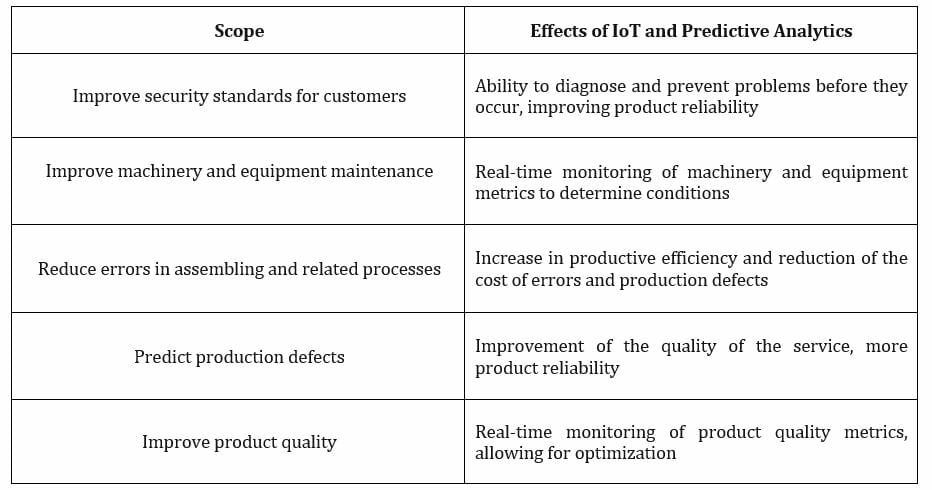
In today’s more dynamic and fast-paced competitive scenario, it is crucial for manufacturing companies to excel in terms of flexibility, resilience and process’ leanness. To achieve these things, it is necessary to implement a system that guarantees the sufficient dynamism to adapt to sudden changes that more and more often are disrupting the supply chains.
In this regard, the rise of digital technologies has prompted many companies to renew their concept of Quality Management, which in the Industry 4.0 can rely on new instruments as IoT devices. These smart sensors can collect a huge amount of data (sometimes labeled as Big Data) that can be real-time monitored or employed by Data Scientists for Machine Learning models to perform Predictive Analytics.
In particular, Predictive Maintenance and Quality Management systems, which were completely human-controlled until a few years ago, can now be optimized and automatized by algorithms that, besides being far more precise than human beings, can also offer the possibility to significantly improve product quality.
Thanks to Predictive Maintenance systems it’s possible to increase customer satisfaction through more accurate estimates of future demand, as well as improving the company’s reputation in terms of reliability and quality of service.
Furthermore, smart devices are able to automatically diagnose and prevent failures, reducing operative expenses and losses related to unplanned downtime.
The following table shows some examples of practical benefits deriving from the introduction of IoT devices and Predictive Analytics with respect to production in manufacturing companies.
How to use Machine Learning for Predictive Maintenance
The first step for realize a proper Predictive Maintenance system is choosing the right data to train our models. Having too many data could be counter-productive as redundant information can impair models’ performances and result in distorted predictions. On the other hand, with insufficient data is hardly possible to build up an effective Predictive Maintenance system. Therefore, we must determine the right metrics that should be employed by our models and choose the appropriate IoT devices to collect the data that we need.
In this phase, it is also crucial to ensure that we pay attention to Data Quality in data collection and ingestion processes, in order to avoid future distortions and other issues.
After obtaining the necessary data, and performing cleaning operations we can realize our Machine Learning model by identifying which variable we should include, in a process that is called feature engineering.
A common mistake in this phase is to skip the feature selection and construct a model that employs all the features collected, hoping for an adequate result. Unfortunately, this approach is hardly able to achieve the desired results as too many variables will result in a less precise and time-consuming model. Thus, in performing those delicate tasks it’s crucial to rely on somebody that has the necessary expertise, which may be a qualified data scientist or an external consultant (as Dataskills, for example).
Eventually, it’s important to remember that this kind of solution is completely different from an alarm system, which usually monitors if a single parameter is above or under a certain threshold. A Machine Learing model employs data from different devices to offer a more precise prediction of a particular event.
Specifically, in Predictive Maintenance there are two techniques that are typically employed:
- Regression models as the Remaining useful lifetime (RUL)
- Classification algorithms to predict failure in a specific time window
Both techniques need time-series data to provide predictions about the future.
RUL is calculated through a regression model that tries to minimize the error of the prediction, which is the difference between the predicted remaining useful lifetime and the actual remaining lifetime of the machine.
In the classification model more we will need to collect more data, but the final predictions will generally be more precise as we can obtain an accurate estimate of a time window in which there is a very good chance that a failure will occur.
Therefore, the maintenance team will be able to take action with the necessary measures if the model is signaling a possible failure. Another technique is to use classification algorithms to determine the cause of the failures, identifying the source of the problem. In this way, it is possible to take effective preventive measures to solve the root of the issue.
To sum it up, Predictive Maintenance is a mix of techniques to provide a prediction about future failures, in order to take actions and avoid slowdowns and production downtime.
This system, if correctly implemented, has the following advantages:
- Reduction of costs associated with failures and related issues;
- Optimization of maintenance operations;
- Minimization of the time spent on maintenance activities;
- Enhancement of machinery and equipment productivity;
- Reduction of costs related to maintenance activities.
The major obstacle in realizing such a system is to collect the necessary data to operate an effective training of the models. For this reason, the first step to start investing in Predictive Maintenance is to implement the proper IoT devices to collect data as soon as possible.
Read More:
- Enhance Data Quality through Machine Learning
- 5 Steps to boost your company with Artificial Intelligence
- How to implement an effective Business Intelligence
Comments are closed.






